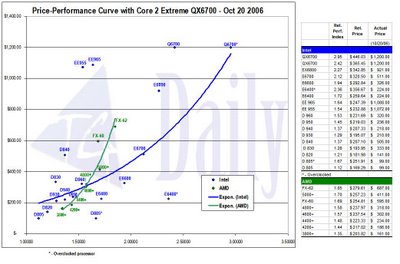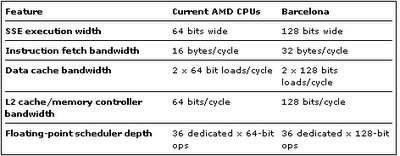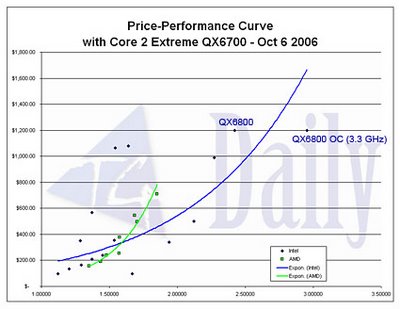Showing posts with label CPU. Show all posts
Showing posts with label CPU. Show all posts
Wednesday, November 15, 2006
Friday, November 10, 2006
Intel eyes nanotubes for future chip designs
 From ZDnet:
From ZDnet:Intel is eyeing carbon nanotubes as a possible replacement for copper wires inside semiconductors, a switch that one day could eliminate some big problems for chipmakers.
The chip giant has managed to create prototype interconnects--microscopic metallic wires inside of chips that link transistors--out of carbon nanotubes and measure how well the interconnects perform. In essence, the experiments are a way to test whether the theories about the properties of carbon nanotubes are accurate.
Sunday, October 29, 2006
Friday, October 27, 2006
Intel Xeon and AMD Opteron Battle Head to Head
From Tomshardware:
The Woodcrest platform performed very well, exceeding our initial expectations. It is the fastest in all of the tests and completely dominates our benchmarks. The new Xeon 5100 series helps Intel to get back on track, providing class-leading server/workstation processors. The now older 5000-series (Dempsey) Xeon, based on the Netburst architecture, is often last in the competition and merely serves as a point of reference in our tests.
Intel has retaken the throne from AMD in the server/workstation sector and sent AMD back to the drawing board. Next month Intel will release the quad core Clovertown CPU with 2 combined Woodcrest cores. AMD is ready for this threat with the introduction of their X4 Opteron, which is reported to have a L3 cache. Servers will benefit more from these quad core processors than desktop users due to the limited deployment of multithreaded-capable applications in the desktop sector in comparison to the server sector.
In mid-2007 AMD is expected to answer Intel's new threat with a line of faster Opterons utilizing the new Socket F, as well as support for DDR2 memory. Whether or not this will be enough to regain the performance lead has yet to be seen, but with no major architectural changes, it is expected that Intel will still retain the overall better performance per watt status.
In all, both platforms perform quite well, but the nod goes to the Xeon 5100 series for its superior performance and greater efficiency.
Wednesday, October 25, 2006
AMD's "Fusion" processor to merge CPU and GPU
From Tomshardware:
AMD today announced that it has completed the acquisition of graphics chip developer ATI. The company does not waste any time to make use of the acquired knowledge: In 2007, AMD will be upgrading its mobile platform and offer a Centrino-like platform as well as integrated solutions for commercial and media systems. And there will be a processor with built-in graphics.
Saturday, October 21, 2006
Price/Performance Charts: Price of Core 2 Extreme drops ahead of quad-core launch

 From Tomshardware:
From Tomshardware:If you plan on upgrading your computer with Intel's fastest processor, this may be your best opportunity yet: The latest update of our Price/Performance Charts reveals a substantial drop in etail pricing - close to $900 and substantially below any price of any other Intel Extreme processor before.
Wednesday, October 11, 2006
AMD Unveils Barcelona Quad-Core Details
From Extremetech:

Processor architecture designs take years from initial conception to the first shipping CPU sliding out of the fab assembly. So it's clear that AMD's new CPU architecture has been in the works for some time. Whether that's a problem or not vis à vis the competition isn't yet known, since AMD isn't yet talking about performance details.
What is known is that Barcelona—as AMD has dubbed this first iteration—isn't so much a brand-new architecture as it is a highly refined, tweaked version of the existing AMD x86-64. Those tweaks are numerous and significant. It's probably fair to suggest that Barcelona is to the current Opterons as Intel's Core 2 is to the Pentium M—designed from the ground up, on a base of the old with a lot of new stuff rolled in.
The details of Barcelona discussed in this article were presented by Ben Sander, who led the performance modeling group for Barcelona. Sander's team cranked real-world application traces through iterations of the new processor—both simulated and real. Although he's uniquely positioned to discuss performance, Sander didn't really comment on performance yet. What he discussed instead were some of the enhancements built into Barcelona.
With these thoughts in mind, let's take a look at some of the shiny new features.
Speeding Up Floating Point
The first thing to realize is that Barcelona is the core of the next Opteron CPU, AMD's server and workstation product line. While it will also serve as the basis for AMD's next-generation desktop CPU, there will undoubtedly be some differences, though AMD isn't commenting on what those might be.
As such, the target markets for a quad-core Opteron are twofold:
High performance technical computing, including applications such as financial analysis, gas and oil exploration, and biological sciences.
Media encode and decode: HD-DVD authoring, video compression, and similar applications.
The key area of commonality between these two application spaces is high-performance floating-point processing. Software has been transitioning to SIMD-style floating point for the last decade, so AMD is substantially beefing up Barcelona's SSE unit, relative to previous Opterons. (SSE is actually an Intel term that stands for streaming SIMD enhancements.) Here's a list of the changes and enhancements.

In addition, SSE MOV instructions can be performed in the floating-point "store" pipe. Two SSE operations can be executed and one SSE move per cycle. There's also a capability now to support an unaligned load/execute mode, which can improve instruction packing and decoding efficiency.
These changes are fairly similar to what Intel has done with the Core 2 processor line, so it should be interesting to compare performance on SSE-heavy applications when the processor ships.
Something Old, Something New
Barcelona is not as radical a change to AMD's microarchitecture as Intel's Core was, relative to NetBurst. But the new quad-core CPU will offer substantial improvements to performance. Just how substantial the improvements will be isn't yet known.
AMD will be showing demos of Barcelona-based systems before the end of the year, with actual CPUs shipping by mid-2007. Until we can actually see a system in action, it's impossible to quantify performance. It will be faster than today's Opteron, to be sure. Will it be fast enough remain competitive? We'll have to see what both AMD and Intel will be offering next summer.
Desktop variants aren't scheduled to ship until the second half of 2007, giving Intel a solid 6 to 7 month lead to cement its reputation as the quad-core leader. AMD would argue that Kentsfield isn't a "true" quad-core, since the Intel processor is really two dual-core CPUs packaged together. But it's unclear whether consumers will really be concerned about the distinction.
Saturday, October 07, 2006
CPU price/performance update: AMD undercuts Intel on the low end
 Price/Performance comparison 6 October 2006
Price/Performance comparison 6 October 2006Let's have a look at the price/performance comparison. In this chart, which does not consider the Intel quad-core processor QX6700, there is a striking difference between the performance-per-dollar values for Intel and AMD. In fact, the standard deviation for Intel's "performance per dollar" is about twice that of AMD.
n case of AMD, almost every processor currently lines up almost perfectly with an exponential price/performance trend curve, translating in a very balanced market pricing of each processor. Intel's processor prices, on the other hand, is much more radically spread out and still have to find their spots.
The Pentium Extreme Edition processors (965 and 955) are clearly overpriced at this time. At a little over $1000, the level of performance is not nearly as high as would be expected. On the flip side, there are some processors that are remarkably under-priced for the level of performance they provide. The Core 2 Duo processors (E6700 and E6600), for example, flatten the trendline for Intel and are priced more than $100 below Intel's exponential curve.
However, overclockers still find the best value in today's market with the Pentium D 805, which is currently available for an average price of $98. When overclocked to 4.1 GHz, it provides roughly the same level of performance as the $1081 Pentium EE 965, or the $546 AMD Athlon 64 FX-60.
If you are undecided which processor to buy, our chart indicates that at least at this time, AMD processors provide more bang for the buck in the mainstream segment of the market. Until a performance index of about 1.6, which includes CPUs up to the Athlon 64 X2 4600+, the blue team remains at a disadvantage.
AMD has in fact seen improvements since our first set of charts in July. On 20 July, our first graph showed that AMD's entire price-performance curve was above Intel's. However, after AMD cut prices on the 64 X2 series, it took over the advantage in the area of low-end processors. Then, as AMD prices continued to fall, Intel's top processors took price cuts, creating the dichotomy we have now. Our graph from 25 August, looks fairly similar to what it's like today. However, the the Core 2 Extreme QX6700 on the way, there may be a new shift on the way.
 When including Intel's Core 2 Extreme QX6700 in the curve - we are using an expected retail price of $1200 for this model, the blue performance curve is slightly flattened, while AMD's current prices receive more pressure. However, AMD's curve will change significantly with the introduction of the 4x4 platform, which will - as we heard - will be available for about $800-$900 in packages of two dual-core processors.
When including Intel's Core 2 Extreme QX6700 in the curve - we are using an expected retail price of $1200 for this model, the blue performance curve is slightly flattened, while AMD's current prices receive more pressure. However, AMD's curve will change significantly with the introduction of the 4x4 platform, which will - as we heard - will be available for about $800-$900 in packages of two dual-core processors.We will have to wait for first benchmark data to determine how much of a value AMD's 4x4 systems will be. According to our curve and assuming a price of $900 - or 27% more than a current FX-62 - 4x4 will need to be 55% faster than a FX-62 system to undercut Intel's price/performance curve.
Subscribe to:
Posts (Atom)










